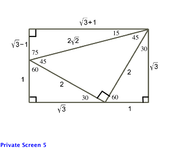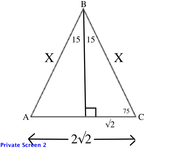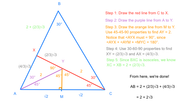In triangle ABC, if angle ABC is 30 degrees, AC = 2 * √2 and AB = BC = X, what is the value of X?
A) √3 - 1
B) √3 + 2
C) (√3 - 1) / 2
D) (√3 + 1) / 2
E) 2 * (√3 + 1)
OA: E
Source: Veritas
Tough Geometry Question
This topic has expert replies
GMAT/MBA Expert
- [email protected]
- Elite Legendary Member
- Posts: 10392
- Joined: Sun Jun 23, 2013 6:38 pm
- Location: Palo Alto, CA
- Thanked: 2867 times
- Followed by:511 members
- GMAT Score:800
Hi Mo2men,
The answer choices to this question are designed in such a way that you can use a bit of logical estimation and eliminate all of the wrong answers.
Based on the description in the prompt, we're dealing with an ISOSCELES triangle (30/75/75) and the 'short side' is 2√2. While you might not immediately know the value of √2, you probably know that 14^2 = 196, so (1.4)^2 = 1.96... thus, you can reasonably estimate √2 = 1.4
Thus, 2√2 is approximately 2.8). By definition, the two longer sides would be considerably BIGGER than 2.8 (not necessarily double, but the ratio of the angles- 75 to 30 - means that X would NOT be close to 2.8), so we can now estimate if any of the answers would be too small relative to what X should probably be.
√3 is clearly less than √4 - so √3 is clearly LESS than 2. Using the same math that you used to determine the approximate value of √2, you can determine that √3 is about 1.7
Answer A: (1.7) - 1 = (0.7). NOT a match.
Answer B: (1.7) + 2 = (3.7). Maybe... but this answer is relatively close to 2.8.....
Answer C: (0.7)/2 = (0.35). NOT a match.
Answer D: (2.7)/2 = (1.35). NOT a match.
Answer E: 2(2.7) = (5.4)
Given the ratio of angles, Answer E makes a lot more 'sense' from a mathematical standpoint than Answer B does.
Final Answer: E
GMAT assassins aren't born, they're made,
Rich
The answer choices to this question are designed in such a way that you can use a bit of logical estimation and eliminate all of the wrong answers.
Based on the description in the prompt, we're dealing with an ISOSCELES triangle (30/75/75) and the 'short side' is 2√2. While you might not immediately know the value of √2, you probably know that 14^2 = 196, so (1.4)^2 = 1.96... thus, you can reasonably estimate √2 = 1.4
Thus, 2√2 is approximately 2.8). By definition, the two longer sides would be considerably BIGGER than 2.8 (not necessarily double, but the ratio of the angles- 75 to 30 - means that X would NOT be close to 2.8), so we can now estimate if any of the answers would be too small relative to what X should probably be.
√3 is clearly less than √4 - so √3 is clearly LESS than 2. Using the same math that you used to determine the approximate value of √2, you can determine that √3 is about 1.7
Answer A: (1.7) - 1 = (0.7). NOT a match.
Answer B: (1.7) + 2 = (3.7). Maybe... but this answer is relatively close to 2.8.....
Answer C: (0.7)/2 = (0.35). NOT a match.
Answer D: (2.7)/2 = (1.35). NOT a match.
Answer E: 2(2.7) = (5.4)
Given the ratio of angles, Answer E makes a lot more 'sense' from a mathematical standpoint than Answer B does.
Final Answer: E
GMAT assassins aren't born, they're made,
Rich
- GMATGuruNY
- GMAT Instructor
- Posts: 15539
- Joined: Tue May 25, 2010 12:04 pm
- Location: New York, NY
- Thanked: 13060 times
- Followed by:1906 members
- GMAT Score:790
The following figure is known as the Ailles rectangle:

The figure above illustrates the following:
In a 15-75-90 triangle, (shorter leg)/(hypotenuse) = (√3 - 1)/(2√2).

In the 15-75-90 triangle on the right, the shorter leg = √2 and the hypotenuse = X.
Since (shorter leg)/(hypotenuse) = (√3 - 1)/(2√2), we get:
(√2)/X = (√3 - 1)/(2√2)
X(√3 - 1) = (√2)(2√2)
X(√3 - 1) = 4
X = 4/(√3 - 1)
X = [4(√3 + 1)] / [(√3 - 1)(√3 + 1)]
X = [4(√3 + 1)] / (3 - 1)
X = [4(√3 + 1)] / 2
X = 2(√3 + 1).
The correct answer is E.

The figure above illustrates the following:
In a 15-75-90 triangle, (shorter leg)/(hypotenuse) = (√3 - 1)/(2√2).
If we split the given triangle in half, the following figure is yielded:Mo2men wrote:In triangle ABC, if angle ABC is 30 degrees, AC = 2 * √2 and AB = BC = X, what is the value of X?
A) √3 - 1
B) √3 + 2
C) (√3 - 1) / 2
D) (√3 + 1) / 2
E) 2 * (√3 + 1)

In the 15-75-90 triangle on the right, the shorter leg = √2 and the hypotenuse = X.
Since (shorter leg)/(hypotenuse) = (√3 - 1)/(2√2), we get:
(√2)/X = (√3 - 1)/(2√2)
X(√3 - 1) = (√2)(2√2)
X(√3 - 1) = 4
X = 4/(√3 - 1)
X = [4(√3 + 1)] / [(√3 - 1)(√3 + 1)]
X = [4(√3 + 1)] / (3 - 1)
X = [4(√3 + 1)] / 2
X = 2(√3 + 1).
The correct answer is E.
Private tutor exclusively for the GMAT and GRE, with over 20 years of experience.
Followed here and elsewhere by over 1900 test-takers.
I have worked with students based in the US, Australia, Taiwan, China, Tajikistan, Kuwait, Saudi Arabia -- a long list of countries.
My students have been admitted to HBS, CBS, Tuck, Yale, Stern, Fuqua -- a long list of top programs.
As a tutor, I don't simply teach you how I would approach problems.
I unlock the best way for YOU to solve problems.
For more information, please email me (Mitch Hunt) at [email protected].
Student Review #1
Student Review #2
Student Review #3
Followed here and elsewhere by over 1900 test-takers.
I have worked with students based in the US, Australia, Taiwan, China, Tajikistan, Kuwait, Saudi Arabia -- a long list of countries.
My students have been admitted to HBS, CBS, Tuck, Yale, Stern, Fuqua -- a long list of top programs.
As a tutor, I don't simply teach you how I would approach problems.
I unlock the best way for YOU to solve problems.
For more information, please email me (Mitch Hunt) at [email protected].
Student Review #1
Student Review #2
Student Review #3
-
Matt@VeritasPrep
- GMAT Instructor
- Posts: 2630
- Joined: Wed Sep 12, 2012 3:32 pm
- Location: East Bay all the way
- Thanked: 625 times
- Followed by:119 members
- GMAT Score:780
Not that I'm against the Ailles rectangle, but I don't think we should assume students would know that or dream it up.
How about this, a very GMAT appropriate way that only requires drawing a few lines and knowing the ratios of 45-45-90 and 30-60-90s. No algebra is used here, and the steps are color coded to the diagram, so you can see what is added at each step:

How about this, a very GMAT appropriate way that only requires drawing a few lines and knowing the ratios of 45-45-90 and 30-60-90s. No algebra is used here, and the steps are color coded to the diagram, so you can see what is added at each step:

-
Matt@VeritasPrep
- GMAT Instructor
- Posts: 2630
- Joined: Wed Sep 12, 2012 3:32 pm
- Location: East Bay all the way
- Thanked: 625 times
- Followed by:119 members
- GMAT Score:780
Two important takeaways from my approach:
1) Drawing a well-chosen line can make seemingly impossible geometry questions very accessible, so when in doubt, ask yourself if you can draw something;
2) Always remind yourself that a GMAT problem can't rely on anything beyond the basics you were taught. You aren't expected to know what to do with a 75° angle - this isn't trigonometry - but if you realize that 75° = 30° + 45°, all of a sudden you can use some very friendly and familiar triangles that you WERE taught.
1) Drawing a well-chosen line can make seemingly impossible geometry questions very accessible, so when in doubt, ask yourself if you can draw something;
2) Always remind yourself that a GMAT problem can't rely on anything beyond the basics you were taught. You aren't expected to know what to do with a 75° angle - this isn't trigonometry - but if you realize that 75° = 30° + 45°, all of a sudden you can use some very friendly and familiar triangles that you WERE taught.




















